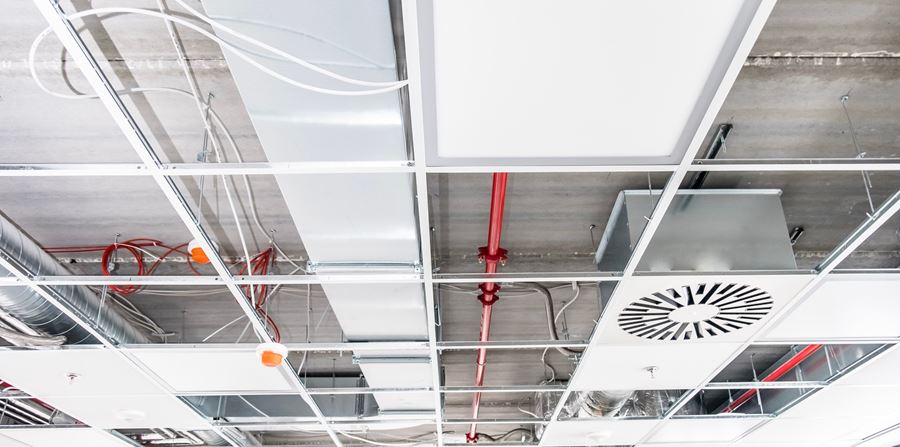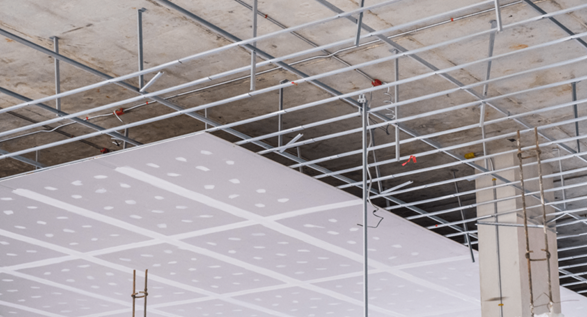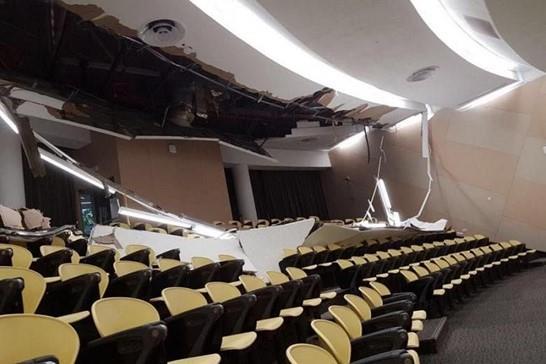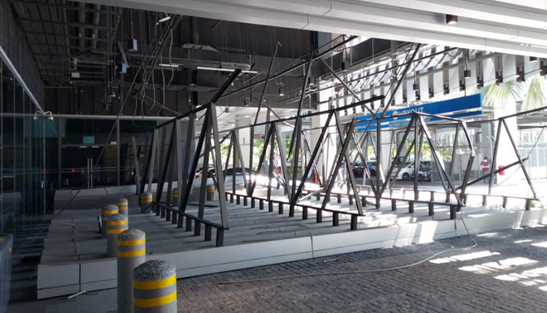False Ceiling Problems in Buildings

This article explores the purpose and construction of false ceilings, the risks that lead to their failure, including design flaws, material degradation, and installation issues. It highlights real-world incidents, forensic engineering insights, and best practices to prevent future collapses.
Trends in Building Complexity
Modern buildings are becoming more complex to satisfy the increasing demands of urbanisation, especially in densely populated cities like Singapore. High-rise structures are a common solution to land scarcity, but they pose new challenges for architects and engineers.
Buildings nowadays must perform versatile functions, such as residential, commercial, educational, or recreational, and accommodate multiple service lines, such as pipes, conduits, cables, and ducts, that run parallel to the floor to distribute water, electricity, air, and data. These service lines are essential for the functionality and comfort of the occupants, but they also take up valuable space and affect the aesthetics of the interior design. Therefore, architects often use false ceilings (sometimes referred to as suspended ceilings) to hide these service lines and create a more pleasing visual effect.
False ceilings are secondary ceilings suspended below the main ceiling, covering service lines and other items. They also have other functions, such as improving the space's acoustics, lighting, and thermal insulation. False ceilings are a vital component of modern architecture that enhances the performance and appearance of buildings.
The Function of a False Ceiling
A typical false ceiling inside a building is an extension of the original ceiling and is often suspended by metal or wooden frames from the original ceiling or roof above. They can be made of materials, such as gypsum board, PVC, POP, wood, steel, or aluminium. Each material has pros and cons in terms of aesthetics, performance, durability, cost, and ease of installation.
Gypsum board is a lightweight, fire-resistant material that is easy to install and environmentally friendly. However, it is more expensive than plasterboard, which is like gypsum but less durable. POP, or Plaster of Paris, is a flexible and durable material that can create unique shapes and designs. It is relatively cost-effective but time-consuming to install. Wood is a natural and warm material that can suit various interior styles. However, wood is unsuitable for humid places, as it can get damaged easily. Metal is a strong, durable, and corrosion-resistant material that is easy to install. However, it is not commonly used in residential designs as it can look cold and industrial.
A false ceiling can improve the appearance of a room by hiding the wires and trunking that run across the roof or under the original ceiling. It can also provide more lighting options, such as spotlights, cove lights, and recessed lights. Moreover, it can lower the room's temperature by trapping air between the original and extended ceiling, thus saving on energy costs. It can also provide sound insulation and better acoustics for the room.
A false ceiling can be installed at various heights depending on the preference of the building owner or tenant and is also dependent on factors, such as building construction, type of lighting fixtures used, and other services required to be hidden (e.g. air conditioning ducts). However, a common height is about six inches from the original ceiling if there is no need to cover major items. A false ceiling should also follow the relevant code of practice for installation and maintenance to ensure safety and quality, if such codes exist.
A typical connection of a false ceiling utilising gypsum board panels suspended from the original concrete ceiling.
False Ceiling Issues and Recent Incidents in Singapore
Recent incidents involving ceiling collapse in Singapore have raised public concerns about the safety and quality of building materials and installation methods. Some of the possible causes of these incidents are:
Design issues
The current practice for designing a false ceiling is to follow so-called "standard" details, which are the contractor's instead of the designer's because no plan submission is required to the authorities. In other words, the design does not require approval.
For example, a 50 Kg/m2 loading allowance is adopted for gypsum board ceilings for typical office areas. This allowance may face challenges when an innovative ceiling style is proposed, as sometimes the load of such a system is much heavier. Therefore, a proper design for the false ceiling is required.
Issues Inherited from Materials
The durability of some materials may degrade over time due to environmental factors, such as humidity and temperature. Lack of maintenance and inspection may also lead to undetected defects or damages in the materials. The life cycle of materials may vary depending on their type and source, and some may not be suitable for long-term use.
(Source: Straits Times)
Installation Issues
Unlike other building structural elements, Singapore has no code of practice or standard design for ceiling works. The contractor’s workmanship and skills may affect the installation quality and reliability. Moreover, no plan submission is required for ceiling works, which means there is no regulatory oversight or quality control by the authorities.
An entire false ceiling and support structure that collapsed. There was no proper documentation covering the design and installation of this ceiling. (Source: Professional Engineer's report)
Usage Issues
Some ceilings may not have access panels provided, which makes it difficult to inspect or repair them. Renovation work may also disturb or damage the ceiling structure, especially if heavy fixtures or fittings are installed without proper support or reinforcement. Environmental issues, such as rainwater leakage onto the ceiling or other forms of water ingress above the false ceiling, can significantly increase the weight of the false ceiling. Cold room freezers typically have insulated suspended ceilings and condensation, or air with a high moisture content, can lead to ice attaching to the ceiling structure thus significantly increasing its weight.
These issues pose potential risks to the occupants and users of the buildings, as well as the public. Therefore, addressing them and implementing preventive measures to ensure the safety and quality of ceiling works before a collapse occurs is important.
Forensic Engineering, Establishing Cause, and Preventing Future Incidents
Forensic engineering is the application of engineering principles and methods to investigate the causes and consequences of failures in structures, systems, or components. One of the areas where forensic engineering can provide valuable insights is the analysis of ceiling collapse incidents. As discussed earlier, ceiling collapses can result from various factors, such as design flaws, material defects, improper installation, environmental conditions, or excessive loading.
Forensic engineering investigations can identify the root cause of the collapse, as well as the sequence of events and the failure modes that led to it. By conducting a detailed analysis of the mechanism of ceiling dropping, forensic engineering can assess the extent of damage and the potential risks to human safety and property. Based on their findings, the forensic engineer can make recommendations to repair or replace the damaged ceiling and make recommendations to prevent similar failures in the future. Additionally, forensic engineering can estimate the cost of the remedial actions and appraise the life cycle of the ceiling, considering factors, such as durability, performance, maintenance, and aesthetics.
Frequently Asked Questions
What are the main causes of false ceiling collapse in buildings?
Design flaws, such as relying on generic contractor details without proper engineering approval, which lead to inadequate load capacity, and material degradation over time due to humidity, temperature, and poor maintenance, also weaken ceilings. Improper installation due to a lack of standardized codes and oversight results in unreliable support. Lastly, usage issues like water leakage, heavy fixtures, and the absence of inspection are all causes of the collapse of false ceilings.
Can water leaks or moisture cause false ceilings to collapse?
Yes, absolutely. In fact, that is one of the main causes of false ceiling collapse.
What equipment can overload a false ceiling system?
- Heavy fixtures or fittings that are installed without proper support or reinforcement
- Multiple service lines running above the ceiling, such as pipes, conduits, cables, and air conditioning ducts
- Water ingress or rainwater leakage onto the ceiling, which adds significant weight
- In cold rooms or freezers, condensation or ice formation on insulated suspended ceilings can significantly increase the load
These overloads exceed the typical design allowance (often around 50 Kg/m² for gypsum board ceilings) and can all lead to ceiling failure.
What are the risks of improper installation in false ceilings?
Some risks of improper installation in false ceilings include structural weakness, which can lead to collapse, damage caused by inadequate support for heavy fixtures, and, perhaps most importantly, safety hazards to occupants and increased maintenance challenges.
Our experts are ready to help.







